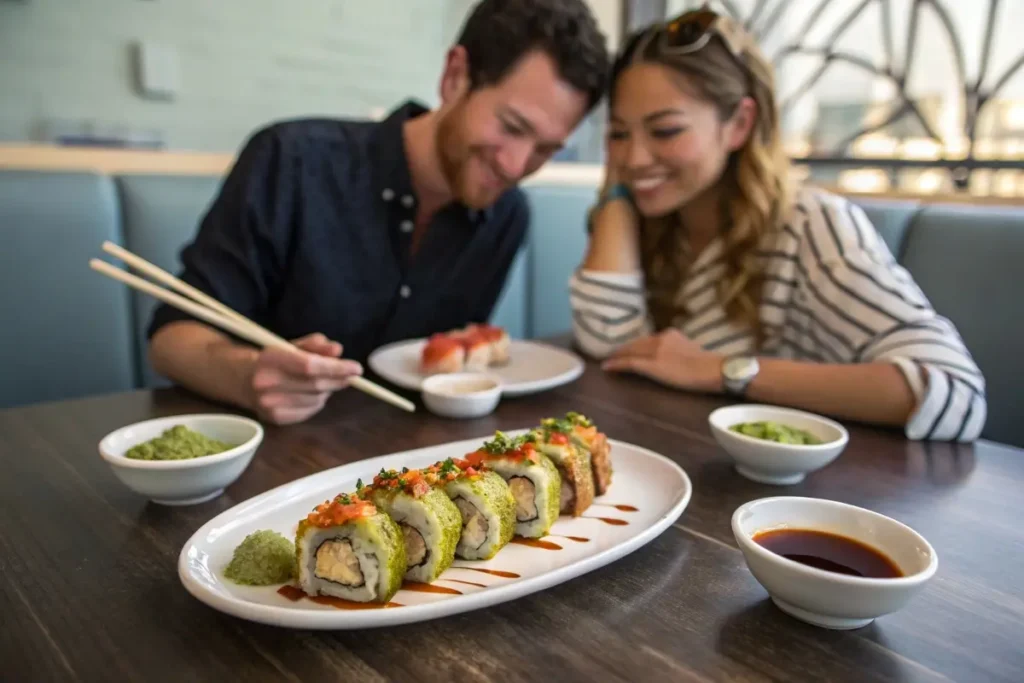The angry dragon roll has captured the hearts (and taste buds) of sushi enthusiasts everywhere. Featuring a fiery blend of Angry dragon roll ingredients like shrimp tempura, spicy sauce, and tangy garnishes, this modern sushi creation packs an addictive crunch with every bite. Whether you’re hunting for an angry dragon roll near me, curious about its calories, or exploring how Angry Dragon roll Wasabi levels elevate its heat, there’s a world of flavor to discover.
Drawing on both traditional sushi-making techniques and new-age culinary twists, the angry dragon roll balances crispy textures with creamy fillings and a playful dose of spiciness. And if you’re ready for dessert afterward, be sure to check out our Japanese Dessert Recipes for a sweet finale to your spicy meal.
Below, we’ll explore everything from the Angry Dragon roll menu basics to advanced tips, Angry Dragon roll Recipe steps, and beyond. Have you ever asked what is an angry dragon in sushi context or wondered how restaurants produce such dramatic flair on the plate? By diving into this guide, you’ll learn the fundamentals, the roll’s evolution, practical serving ideas, and frequently asked questions. Ready to embark on a sizzling sushi journey? Let’s roll!
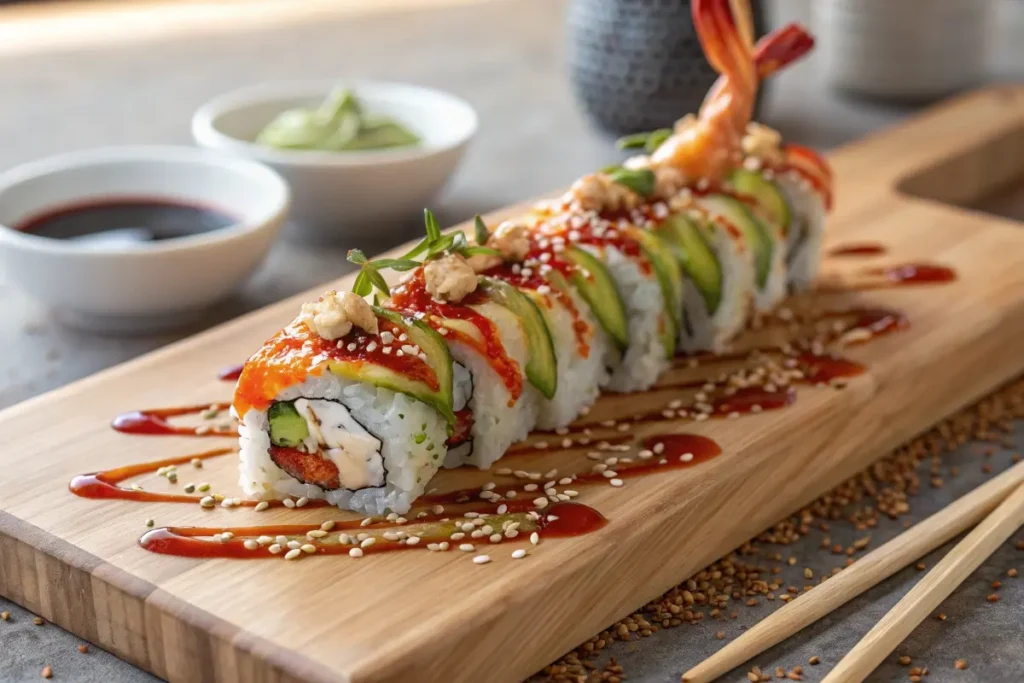
The Essentials of the Angry Dragon Roll
The angry dragon roll might be described as a variation of the classic dragon roll, amplified by spicy sauces and bold flavor contrasts. But what sets it apart from your usual sushi fare?
1.1 Defining Characteristics
- Spicy Edge: The “angry” moniker typically comes from a zesty sauce made with elements like sriracha, spicy mayo, or even wasabi-infused condiments.
- Signature Crunch: Often anchored by fried shrimp or tempura shrimp inside, adding that light crispiness contrasting with soft sushi rice.
- Dragon-Like Appearance: Some chefs position shrimp tails or avocado slices to mimic a dragon’s spines or tail. A final drizzle of bright sauces helps evoke the dramatic “angry” aspect.
1.2 Common Ingredients
- Tempura Shrimp: The crispy star, delivering a fun textural pop.
- Spicy Mayo: Combines mayonnaise with sriracha or chili sauce for that signature tang.
- Cucumber or Avocado: Provides cooling relief from the heat.
- Nori Seaweed: Wraps everything neatly inside.
- Sticky Sushi Rice: Lightly seasoned with vinegar, sugar, and salt.
For those wishing to replicate the angry dragon roll sushi experience at home, it’s crucial to gather high-quality shrimp, fresh produce, and sushi-grade rice. One might also incorporate bright wasabi accents. If you’re exploring the interplay of spicy flavors in Japanese cuisine, consider pairing your roll with recipes from our Japanese Scallop Recipe for a surf-and-turf sushi feast.
1.3 Why the “Angry” Label?
While there’s no single rulebook for sushi naming, the term “angry” signals intense spice or extra heat. Some versions might push the limits with chili flakes or double the wasabi—ideal for spice thrill-seekers. This resonates with adventurous eaters searching for more punch than a standard California or Philadelphia roll.
1.4 Variations across Restaurants
Seek an angry dragon roll near me and you’ll quickly notice differences in sauce recipes, roll shapes, or garnish style. Some chefs rely on jalapeño-based sauces, while others incorporate unagi sauce or swirl in a sweet chili glaze for a sweet-spicy punch. The concept remains flexible, letting each sushi bar craft its own signature spin.
1.5 Taste Profile
Imagine biting into a swirl of crisp shrimp, creamy avocado, tangy vinegar rice, a brush of wasabi, and a final spicy sauce drizzle. The outcome is a layered sensation of crunch, creaminess, tang, and heat—a rollercoaster for your palate. Perfect for fans of bold flavors who also appreciate sushi traditions.
For those concerned about Angry dragon roll calories, rest assured that while it’s not the lightest roll (thanks to tempura and sauce), mindful portion sizes and balancing it with simpler rolls can keep your sushi feast health-conscious. We’ll delve deeper into nutritional angles in a later section.
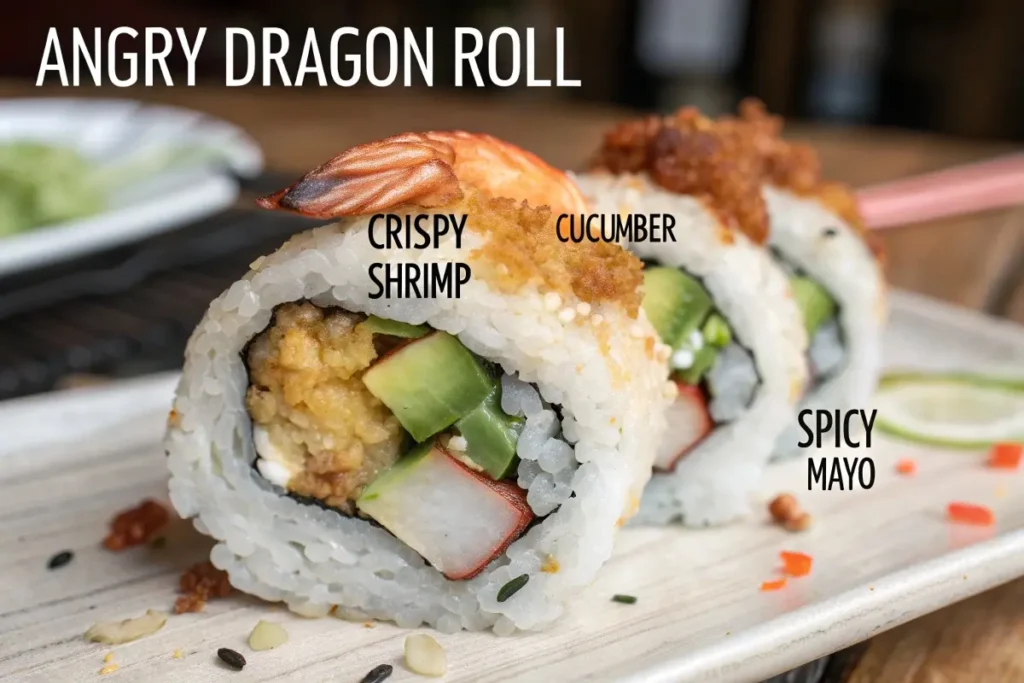
Key Ingredients & Flavor Profiles
While the angry dragon roll sports unique flair, its building blocks still connect to classic sushi traditions. Let’s see how each ingredient influences taste and texture.
2.1 Sushi Rice Basics
- Short-Grain Rice: Known for stickiness, essential for shaping the roll.
- Seasoning: A mixture of rice vinegar, sugar, and salt called sushizu adds subtle sweetness.
- Texture: Properly prepared sushi rice holds shape without being mushy or too stiff.
2.2 The Role of Tempura Shrimp
- Crunch Factor: Tempura batter, when freshly fried, remains airy and crisp.
- Neutral Base: Shrimp’s mild sweetness pairs well with pungent sauces.
- Visual Appeal: A tail protruding from the roll underscores the “dragon tail” concept.
2.3 Avocado vs. Cucumber
- Avocado: Lends a buttery, fatty mouthfeel that complements spicy sauces.
- Cucumber: Refreshing crunch, more neutral. A great option if you prefer a lighter taste.
- Using Both: Many angry dragon roll sushi variations combine them for layered textures.
2.4 The Spicy Sauce Dynamic
Sriracha: The standard for boosting heat, recognized for its garlicky chili punch.
Spicy Mayo: Mayo blended with chili sauce, sriracha, or gochujang for a creamier heat. Some might add Angry Dragon roll Wasabi swirl for an eye-watering kick.
Eel Sauce (Unagi Sauce): A sweet-savory drizzle often used in tandem with spicy sauce for balanced complexity.
2.5 Supplemental Toppings
- Tobiko or Masago: Tiny fish roe that add popping texture and color.
- Tempura Flakes: For those who crave extra crunch.
- Fried Onions or Garlic Chips: Occasionally found in certain versions, introducing umami or smoky notes.
2.6 Selecting Fresh Produce
Because Angry Dragon roll ingredients revolve around raw or partially cooked seafood, product freshness is paramount:
- Shrimp Quality: Opt for large, deveined shrimp. The best taste emerges from freshly battered and fried, not pre-cooked or leftover tempura.
- Veggies: Crisp lettuce or slivered bell peppers might appear in some iterations. Wash thoroughly to ensure no hidden grit disrupts the roll’s silky flow.
If you’re eyeing a do-it-yourself approach, reviewing basics like sushi rice cooking times or sauce-making can be beneficial. Our Discover Japanese Recipes section covers foundational topics to help novices refine their technique. Combine these skills with fresh produce, and you’re set to craft an unforgettable angry dragon roll.
2.7 Balancing Heat Levels
Some prefer a subtle spark; others demand tear-inducing spice. Chefs or home cooks can adjust:
- Less Heat: Swap sriracha for mild chili sauce or reduce the ratio.
- More Intense: Double up on chili flakes, drizzle wasabi oil, or use a spicier pepper sauce.
By mixing and matching these elements, you create a cohesive flavor journey—from crispy tempura shrimp to tangy sauce bursts. The synergy of sweet, spicy, creamy, and crunchy elevates this roll from humdrum to pure culinary drama.
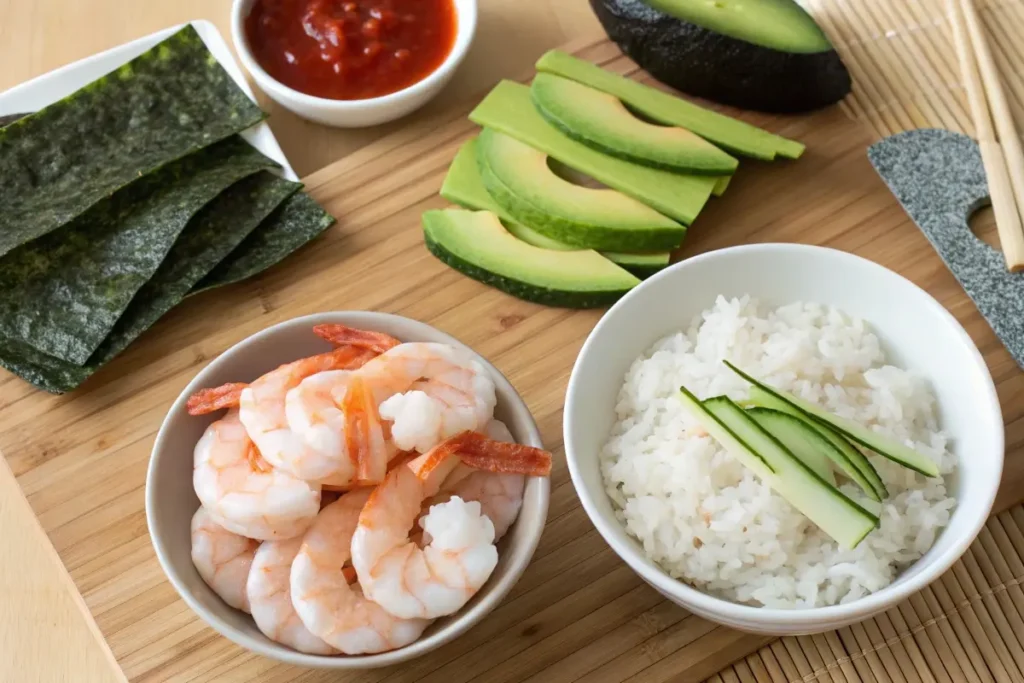
Rolling & Assembly Techniques
Mastering an Angry Dragon roll Recipe often boils down to technique. Even the tastiest ingredients can flop if rolled haphazardly. Let’s break it down step by step.
3.1 Setting the Stage
- Mise en Place: Have everything laid out: bamboo mat (wrapped in plastic for easier cleanup), nori sheets, water bowl for moistening hands, and all fillings.
- Rice Placement: Place half a nori sheet on the mat with the rough side facing up. Spread sushi rice evenly, leaving a small margin at the top for sealing.
3.2 Internal Fillings
- Tempura Shrimp: Position near the bottom edge so it rests horizontally. If the shrimp is extra large, you might need to slightly overlap or trim it.
- Avocado/Cucumber: Lay slices just above the shrimp. For added color, slip in thin carrot sticks.
- Optional Drizzle: Some prefer a small line of spicy mayo or wasabi sauce inside for extra flavor.
3.3 Rolling Steps
- Lift and Roll: Grasp the bamboo mat edge and fold it over the filling, tucking firmly to form a cylinder.
- Tighten: Use gentle pressure to keep the roll intact. Pause to moisten the top nori margin with water or a bit of sushi vinegar if needed.
- Complete the Roll: Continue rolling until sealed. Carefully remove the mat to reveal a neat cylinder.
- Adjust for “Dragon” Aesthetics: For an inside-out version, you place the rice side facing the mat, so the rice ends up on the outside. Then top with sliced avocado or add a final sauce.
3.4 Cutting the Roll
- Knife Prep: A sharp, moist blade ensures clean cuts. Wipe it after each slice to prevent rice or sauce buildup.
- Portions: Typically, 6-8 pieces per roll. If the shrimp tail is protruding, you can angle your cuts to preserve that dramatic effect.
3.5 Presentation Tips
For an angry dragon roll menu star item, dramatic plating matters. Drizzle more spicy mayo or eel sauce in zigzag patterns. Sprinkle sesame seeds or a scattering of green onions. Serve with wasabi, pickled ginger, or a small side of chili-laden dipping sauce to highlight its “angry” persona.
3.6 Troubleshooting
- Roll Not Sealing: Add a bit more moisture at the nori edges. Also ensure you’re not overstuffing.
- Tempura Losing Crunch: Fry shrimp right before rolling or use a second pass of tempura flakes for extra crisp.
- Uneven Slices: Practice consistent blade angles and keep your cutting surface stable.
If you want additional sauce inspiration for drizzling, see our Japanese Barbecue Sauce Recipes—some sweet or tangy variations can complement the roll’s spice. With a bit of repetition, you’ll perfect the Angry Dragon roll shaping process, guaranteeing Instagram-worthy slices that deliver a spicy, satisfying crunch.
Toppings, Sauce, and Plating
The difference between a mediocre sushi roll and a showstopping angry dragon roll often lies in finishing touches. Let’s explore how each topping or sauce can elevate the experience.
4.1 Signature Spicy Sauce
Spicy Mayo
- Mix mayonnaise (Japanese Kewpie recommended) with sriracha or chili sauce. Ratio depends on heat tolerance: start 2:1 (mayo:chili) and adjust.
- Drizzle atop the roll in thin lines or zigzags. Alternatively, place it in a small side dish for dipping.
Wasabi Infusion
- For an Angry Dragon roll Wasabi twist, incorporate wasabi paste into the spicy mayo or add dollops on top.
- Wasabi also pairs with soy sauce if you prefer a classic dip, but be mindful—excess wasabi plus hot chili sauce can become overpowering.
4.2 Crunchy Elements
Tempura Flakes
- Sometimes referred to as tenkasu. They add visual dimension and maintain the crackle if the shrimp’s interior has lost some crispness.
- Scatter them on top or press them onto the outer rice layer for textural intrigue.
Tobiko or Masago
- Bright orange fish roe often sprinkled on top. They burst with subtle saltiness, balancing the roll’s spice.
- Some variations might use black or green tobiko for color contrast.
4.3 Layering Freshness
- Sliced Avocado: Overlapping slices create a scaly “dragon-like” effect. A gentle brush of lemon juice prevents browning.
- Green Onions or Chives: Fine chop adds a mild onion aroma, a color pop, and synergy with the spicy sauce.
4.4 Artistic Plating
Sauce Patterns
- Use squeeze bottles or piping bags for precision. A swirl of unagi (eel) sauce around the plate can offset the roll’s spiciness with sweet notes.
- Sprinkling sesame seeds or chili flakes on the sauce drizzle ensures the “angry” theme stands out visually.
Creating a “Dragon” Silhouette
- Some chefs shape the roll into an S-curve, place decorative garnishes at the head and tail ends (like shrimp or a carved cucumber piece resembling a dragon face).
- For an Instagram-worthy shot, garnish with microgreens or edible flowers, though this step is optional.
4.5 Ensuring Harmony
Because the angry dragon roll relies on multiple strong flavors—spice, sweet, crisp—it’s essential not to overshadow the shrimp’s natural sweetness. If you’re uncertain about sauce combos, test a small piece before final assembly.
Side Accompaniments
- Pickled Ginger: Cleanses the palate between bites.
- Soy Sauce: A universal dipping staple, though you might skip if you prefer the spicy mayo or eel sauce flavors.
- Wasabi: Additional bursts of heat for those needing extra “angry” flair.
If you’re curious about pairing these spicy rolls with mild side dishes, try exploring our Japanese Chicken Fried Rice Recipe for a balanced meal. The rice’s savory comfort can calm the roll’s fiery bite.
Health & Nutrition Info for the Angry Dragon Roll
While sushi is often viewed as a healthy option, the angry dragon roll carries a few considerations—particularly Angry dragon roll calories from frying and sauces.
5.1 Calorie Breakdown
- Tempura Shrimp: Frying adds oil-based calories. A typical piece of shrimp tempura might hold around 60-80 calories, multiplied by the number of shrimp used.
- Sushi Rice: Each roll includes about 1/2 to 3/4 cup of cooked rice. That’s roughly 100-150 calories, depending on portion sizes.
- Spicy Mayo: Mayo plus chili sauce can contribute an additional 50-100 calories per tablespoon. Drizzles add up quickly.
- Avocado: Healthy fats, though half an avocado is about 120-150 calories.
5.2 Balancing Act
Moderation remains key. Indulging in one angry dragon roll is typically fine for occasional treat meals. Pair it with simpler rolls (like cucumber maki) or miso soup to round out the meal without racking up excessive total calories.
5.3 Protein and Nutrients
- Shrimp: Provides lean protein, plus minerals like selenium.
- Seaweed (Nori): Offers iodine and small amounts of vitamins.
- Avocado: Rich in healthy monounsaturated fats, fiber, potassium, and vitamin E.
If you’d like to reduce calorie load but retain flavor, you can:
- Opt for one shrimp tempura per roll instead of two.
- Use less sauce or drizzle instead of dunking each piece.
- Incorporate more fresh veggies, like carrot strips or bell peppers, increasing volume without major added calories.
5.4 Lowering the Heat or the Calories
Less Mayo: Switch to a thin chili-based sauce or light soy sauce mixed with chili flakes.
Baked Variation: Some might skip deep-frying the shrimp in favor of lightly baking battered shrimp for reduced oil absorption.
Whole Grain Rice: Rare, but some sushi chefs experiment with partially milled or brown sushi rice for extra fiber.
5.5 Considering Dietary Restrictions
- Gluten-Free: Tempura batter typically contains wheat. Seek gluten-free flours or an alternate cooking method if needed. Similarly, check that your soy sauce is GF.
- Shellfish Allergies: Obviously avoid shrimp. A salmon or tofu tempura could form an “angry salmon roll,” but the vibe might differ.
- Spice Sensitivities: Reduce sriracha or wasabi usage. The structure of the roll remains, only the sauce changes.
If you’re exploring more health-focused recipes, our Healthy Japanese Recipes might give you further strategies to adapt the angry dragon roll to your dietary preferences, ensuring a guilt-free, delicious experience.
History/Context
Though not an ancient fixture of traditional sushi, the angry dragon roll is a testament to sushi’s evolving, global nature. Where did it come from, and how did it gain popularity?
Origins in Fusion Sushi
In the 20th century, sushi began expanding beyond Japan. Western countries gravitated toward creative rolls with cooked seafood (like shrimp tempura) and flamboyant sauces. Chefs realized a “dragon” motif, typically associated with eel or shrimp, garnered attention and triggered curiosity.
The “angry” aspect likely emerged as chefs experimented with spicier condiments—matching the Western palate’s appetite for bold flavors. Hot sauce, sriracha, and chili-based mayo soon became staples, turning standard dragon rolls into “angry dragon” variants. This spiciness gave sushi bars an easy way to stand out.
The Role of American Sushi Culture
Cities like Los Angeles, New York, and Vancouver played pivotal roles. Japanese-American chefs introduced synergy between local produce, southwestern chiles, or sriracha. Menus featuring playful names, like angry dragon roll, volcano roll, or spicy rainbow roll, appealed to newcomers less accustomed to raw fish or minimalistic nigiri.
Evolution in Presentation
As plating artistry blossomed, the “dragon” name became literal. Chefs shaped the rolled cylinder to mimic a snake or dragon tail, topping it with avocado “scales” or shrimp tails. Flaming sauces or vibrant chili mayonnaise accentuated the “fiery” motif.
Modern Adaptations
Today, the angry dragon roll menu might appear in high-end sushi bistros, casual chain restaurants, and neighborhood sushi bars alike. It’s recognized by novices and connoisseurs, bridging the gap between safe cooked shrimp and the thrilling dimension of chili-laced condiments. Social media hashtags like #angrydragonroll share countless images of spicy-sauced rolls loaded with shrimp or even soft-shell crab.
Cultural Impact
While some purists argue these heavily sauced, flamboyant rolls deviate from sushi’s minimalist roots, many see them as proof of sushi’s adaptability. The angry dragon roll stands as a prime example of cross-cultural fusion: Eastern staple ingredients meeting Western spiciness, culminating in a globally beloved dish. If you’re craving more background on Japanese-inspired creations, visit our Japanese Chicken Curry Recipe to see how curry culture also adapted across borders.
Hence, while the “angry dragon” concept isn’t centuries old, it’s become a modern classic—proving that sushi is not a static tradition but an ever-evolving canvas for culinary creativity.
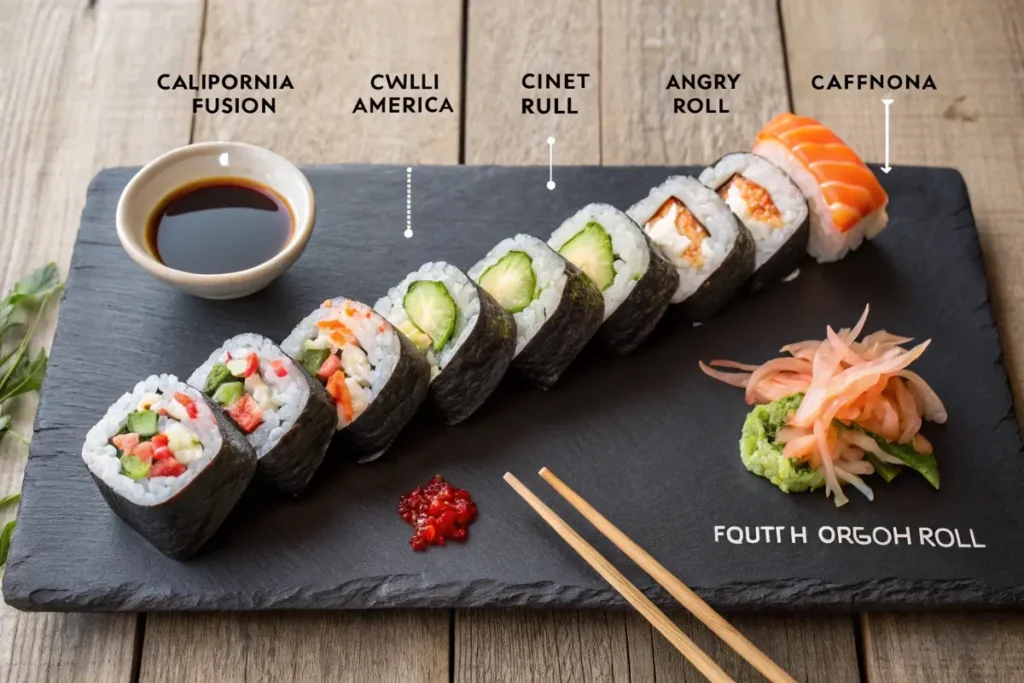
Practical Examples/Use Cases
Looking for ways to incorporate the angry dragon roll beyond a typical sushi bar setting? Here are some scenarios:
1. DIY Sushi Night
Scenario: You’re hosting friends for a sushi-making party.
- Approach: Prep tempura shrimp ahead, set out nori, sushi rice, and an array of sauces (spicy mayo, sriracha, wasabi). Let guests assemble their own angry dragon roll variations.
- Benefit: Encourages interactive cooking, plus everyone customizes heat levels.
2. Restaurant Menu Spotlight
Scenario: A local sushi restaurant wants to boost sales with a new signature item.
- Approach: Feature the angry dragon roll in a special menu section with bold fonts and a brief backstory. Add an “extra spice” option for thrill-seekers.
- Outcome: Elevates brand identity—customers recall the memorable spicy roll and become repeat visitors.
3. Fusion Food Truck
Scenario: A mobile food truck blending Asian and Western flavors.
- Approach: Offer angry dragon roll sushi with a twist—maybe a battered fish interior or a tangy kimchi slaw topping.
- Upshot: Lures crowds at festivals, stands out from typical street fare. Marketing the roll’s “anger” can be a fun talking point.
4. Corporate Events or Catering
Scenario: A caterer managing upscale receptions or office lunches.
- Approach: Offer a mini “angry dragon bite”—small, pre-cut pieces in bite-sized shapes, garnished with microgreens.
- Advantage: Delivers an exotic, flavorful sushi highlight in a convenient portion that doesn’t require large plates or heavy table setups.
5. Health-Conscious Meal Prep
Scenario: You want a tasty, spicy treat without dining out.
- Approach: Prepare a baked shrimp version, use minimal mayo, or skip some toppings. The angry dragon roll can be made lighter, suiting weekly meal preps.
- Benefit: Satisfies cravings for sushi and spice while controlling calorie intake.
Whichever setting you choose, the angry dragon roll can adapt. For side dish inspiration, see our Vegetables Japanese Recipe to incorporate a healthy vegetable stir-fry or miso-glazed greens, balancing out the spiciness. The possibilities are endless—just let your palate guide you toward the right fusion of flavors and presentation style.
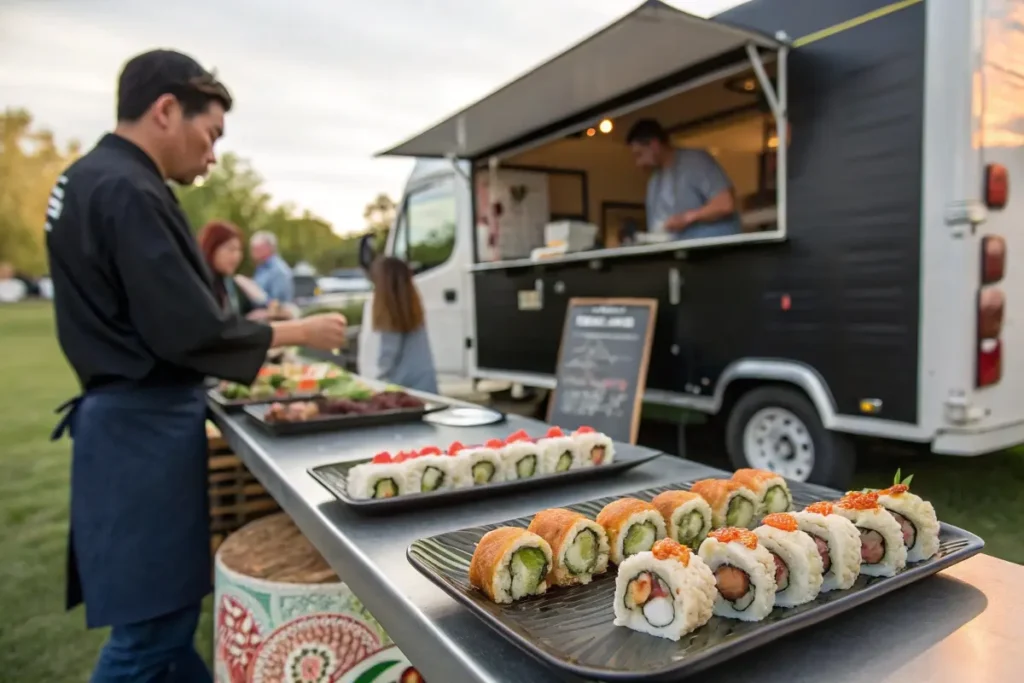
FAQs
1. Angry dragon roll ingredients—what are the basics?
Typically, shrimp tempura, sushi rice, nori, cucumber or avocado, and a spicy sauce form the roll’s core. Add-ons like tobiko (fish roe) or sesame seeds can appear for extra flavor and color.
2. How do I find an angry dragon roll near me?
Check local sushi bars or Japanese restaurants. Many modern fusion places highlight it in their specialty rolls. Some might label it differently, so scanning descriptions for “spicy shrimp tempura roll” or “dragon-themed” items can help.
3. Angry dragon roll recipe—is it complicated?
Not necessarily. While it demands some sushi-rolling skills, it’s manageable once you master sushi rice prep and tempura frying. The main complexity lies in balancing the spicy sauce and ensuring the shrimp stays crisp.
4. Does the angry dragon roll appear on every menu?
Not all spots carry it explicitly as “angry dragon roll.” However, a similar roll might exist under a different name. The spicy shrimp tempura concept is quite prevalent, just rebranded across menus.
5. What if I can’t handle intense spice?
Request mild sauce or omit extra chili or wasabi. Many sushi chefs are happy to adjust. The roll’s structure remains appealing, even minus heavy heat.
6. Angry Dragon roll Wasabi—how does it differ from typical wasabi usage?
Some versions incorporate wasabi directly into spicy mayo or drizzle wasabi oil. This blends wasabi’s pungency with chili spiciness for a double kick. If you prefer the usual dab of wasabi on the side, that works too.
7. Angry Dragon roll calories—are they high?
They can be moderate to high, primarily due to tempura frying and sauce. Approximations range 300-500 calories per roll, depending on portion size and toppings. For a lighter spin, reduce sauce or use baked shrimp.
Conclusion
The angry dragon roll represents the best of modern sushi fusion—crunchy shrimp tempura, tangy sauces, and a dose of spice that sets it apart from traditional favorites. Whether you discovered it at a local sushi bar, encountered it on an adventurous angry dragon roll menu, or want to try your hand at a homemade Angry Dragon roll Recipe, its bold flavors and dynamic textures promise a memorable dining experience. Don’t let the “angry” notion scare you off; you can easily dial the heat up or down to match your comfort zone.
Feeling inspired? Grab fresh shrimp, nori, your favorite chili sauce, and a bamboo rolling mat, and let your creativity shine. The world of sushi is vast and ever-evolving, and the angry dragon roll stands as a tasty testament to that evolution. For more Japanese-inspired dishes to pair with your sushi, check out our Japanese Curry Recipe One Piece for a whimsical spin on classic curry. Embrace the spice, savor the crunch, and create your own signature version of this fiery roll—whatever your palate craves, the angry dragon roll can adapt, ensuring sushi night remains nothing short of spectacular.
